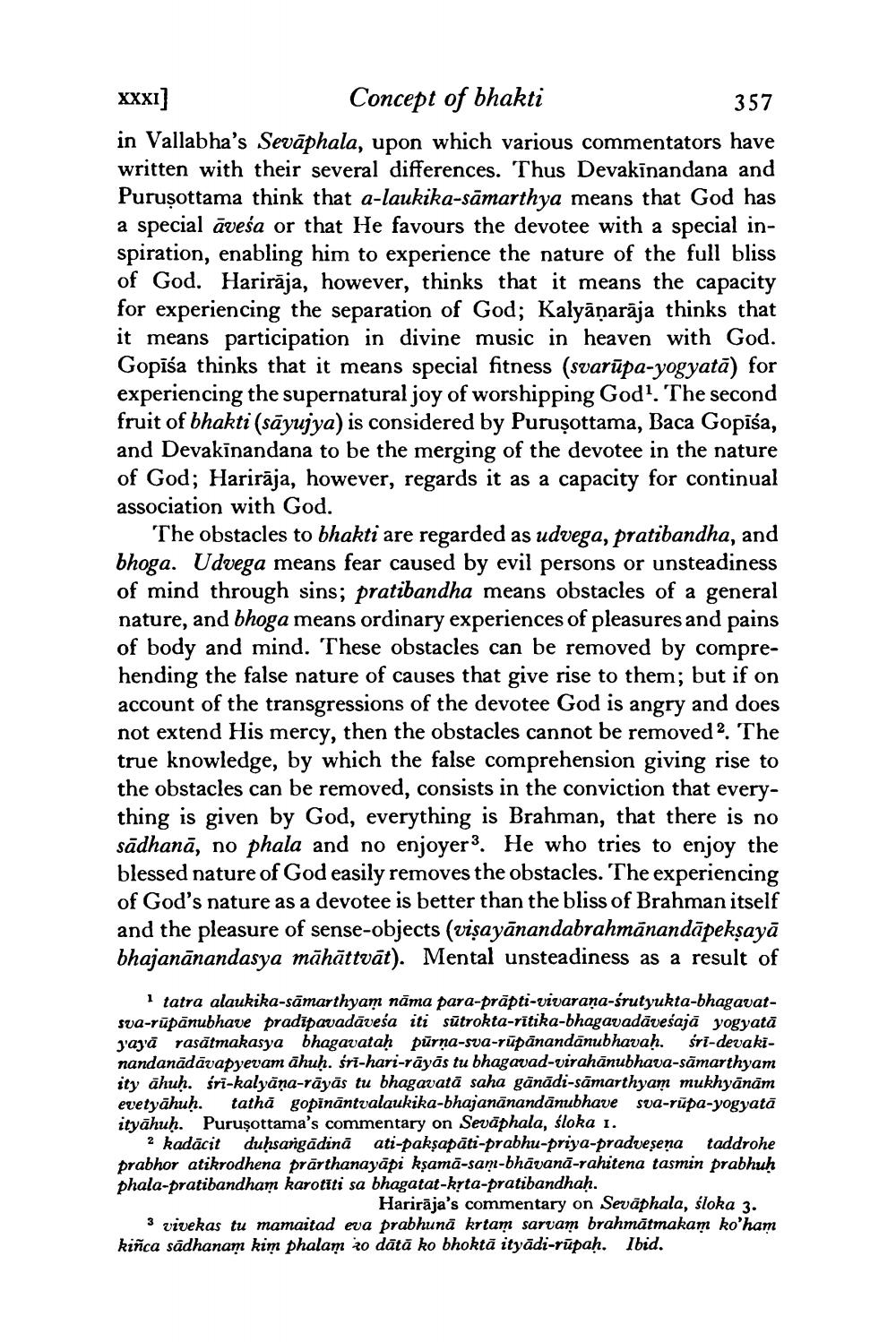________________
XXXI Concept of bhakti
357 in Vallabha's Sevāphala, upon which various commentators have written with their several differences. Thus Devakinandana and Purușottama think that a-laukika-sāmarthya means that God has a special aveśa or that He favours the devotee with a special inspiration, enabling him to experience the nature of the full bliss of God. Harirāja, however, thinks that it means the capacity for experiencing the separation of God; Kalyāṇarāja thinks that it means participation in divine music in heaven with God. Gopīša thinks that it means special fitness (svarūpa-yogyatā) for experiencing the supernatural joy of worshipping God'. The second fruit of bhakti (sāyujya) is considered by Purusottama, Baca Gopisa, and Devakinandana to be the merging of the devotee in the nature of God; Harirāja, however, regards it as a capacity for continual association with God.
The obstacles to bhakti are regarded as udvega, pratibandha, and bhoga. Udvega means fear caused by evil persons or unsteadiness of mind through sins; pratibandha means obstacles of a general nature, and bhoga means ordinary experiences of pleasures and pains of body and mind. These obstacles can be removed by comprehending the false nature of causes that give rise to them; but if on account of the transgressions of the devotee God is angry and does not extend His mercy, then the obstacles cannot be removed 2. The true knowledge, by which the false comprehension giving rise to the obstacles can be removed, consists in the conviction that everything is given by God, everything is Brahman, that there is no sādhanā, no phala and no enjoyers. He who tries to enjoy the blessed nature of God easily removes the obstacles. The experiencing of God's nature as a devotee is better than the bliss of Brahman itself and the pleasure of sense-objects (visayānandabrahmanandāpekṣayā bhajanānandasya māhāttvāt). Mental unsteadiness as a result of
1 tatra alaukika-samarthyam nāma para-prāpti-vivarana-śrutyukta-bhagavatsva-rūpānubhave pradipavadāvesa iti sūtrokta-rītika-bhagavadāveśajā yogyatā Jajā rasātmakasya bhagavataḥ pūrņa-sva-rūpānandānubhavaḥ. sri-devakinandanādāvapyevam āhuḥ. sri-hari-rāyās tu bhagavad-virahānubhava-sāmarthyam ity ahuḥ śri-kalyāna-rāyās tu bhagavatā saha gānādi-samarthyam mukhyānām evetyāhuḥ. tathā gopināntvalaukika-bhajanānandānubhave sua-rupa-yogyatā ityāhuḥ. Puruşottama's commentary on Sevāphala, sloka 1.
2 kadācit duḥsargādinā ati-pakşapāti-prabhu-priya-pradvesena taddrohe prabhor atikrodhena prarthanayāpi kşamā-sam-bhāvanā-rahitena tasmin prabhuh phala-pratibandham karotīti sa bhagatat-kyta-pratibandhaḥ.
Harirāja's commentary on Sevāphala, śloka 3. 3 vivekas tu mamaitad eva prabhunā krtam sarvam brahmātmakam ko'ham kiñca sādhanam kim phalam ko dātā ko bhoktă ityādi-rūpah. Ibid.




